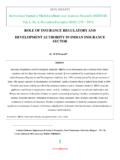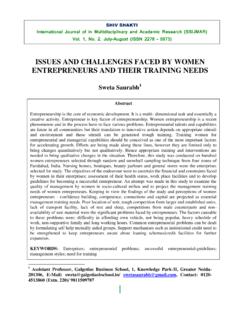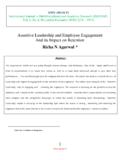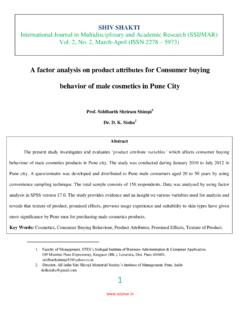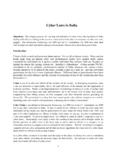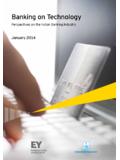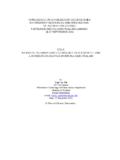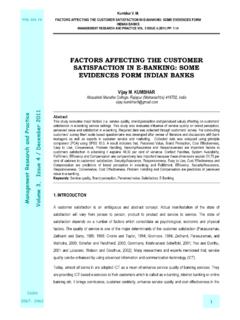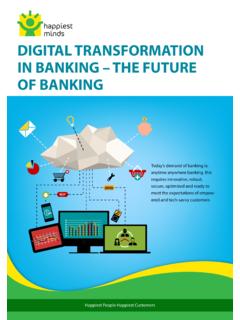Transcription of Role of Information Technology in Indian Banking …
1 1 Role of Information Technology in Indian Banking Sector Prof. Sharma1 Abhinav Sharma2 1. Department of EAFM, Govt. PG College, Alwar (Rajasthan). Contact No. - +91-9784866460 2. Dr. Modi Univ., Newai (Rajasthan), B-170, Ranjeet Nagar, Alwar-301001 Contact +91-998239370,E-mail:- SHIV SHAKTI International Journal in Multidisciplinary and Academic Research (SSIJMAR) Vol. 2, No. 1, January-February (ISSN 2278 5973) Abstract Information Technology refers to the acquisition, processing, storage and dissemination of all types of Information using computer Technology and telecommunication systems.
2 Technology includes all maters concerned with the furtherance of computer science and Technology and with the design, development, installation and implementation of Information system and applications. Information Technology architecture is an integrated framework for acquiring and evolving IT to achieve strategic goals. It has both logical and technical components. Computer hardware and software, voice, data, network, satellite, other telecommunications technologies, multimedia are application development tools. These technologies are used for the input, storage, processing and communication of Information . Information Technology includes ancillary equipment, software, firmware and similar procedures, services etc.
3 Modern high throughput technologies are providing vast amounts of the sequences, expressions and functional data for genes and protein. One of the most difficult challenges is turning this enormous pool of Information into useful scientific insight and novel therapeutic products. Keywords: Computer, Information Technology , Telecommunications. 2 Role of Information Technology in Indian Banking Sector Introduction With the globalization trends world over it is difficult for any nation big or small, developed or developing, to remain isolated from what is happening around. For a country like India, which is one of the most promising emerging markets, such isolation is nearly impossible. More particularly in the area of Information Technology , where India has definitely an edge over its competitors, remaining away or uniformity of the world trends is untenable.
4 Financial sector in general and Banking industry in particular is the largest spender and beneficiary from Information Technology . This endeavours to relate the international trends in it with the Indian Banking industry. The last lot includes possibly all foreign banks and newly established Private sector banks, which have fully computerized all the operations. With these variations in the level of Information Technology in Indian banks, it is useful to take account of the trends in Information Technology internationally as also to see the comparative position with Indian banks. The present article starts with the banks perception when they get into IT up gradation. All the trends in IT sector are then discussed to see their relevance to the status of Indian banks.
5 IT Considerations Since the early nineties, each Indian bank has done some IT improvement effort. The first and foremost compulsion is the fierce competition. While deciding on the required architecture for the IT consideration is given to following realities. (1.) Meeting Internal Requirement: The requirements of the banks are different individually depending upon their nature and volume of business; focus on a particular segment, spread of branches and a like. Many a time s banks do have the required Information but it is scattered. The operating units seldom know the purpose of gathering the Information by their higher authorities. (2.) Effective in Data Handling: As stated earlier the banks have most of the needed data but are distributed.
6 Further the cost of collection of data and putting the same to use is prohibitively high. The accuracy and timeliness of data generation becomes the causalities in the process. Best of the intentions on computerization are wished away because there is non-visible reduction in cost /efforts/time required for the required data gathering. (3.) Extending Customer Services: Addressing to rising customers expectations is significant particularly in the background of increased competition. In case bank A is unable to provide the required service at a competitive price and in an accurate manner with speed. 3 There is always a bank IT at its next-door waiting to hire the customer. Awareness of customers about the availability of services and their pricing as also available options have brought into sharp focus the issue of customer satisfaction.
7 (4.) Creative Support for New Product Development: It has become necessary for the banks to vitalize the process of product development. Marketing functionaries needs a lot of Information not only from the outside sources but also from within the banks. Banks are looking to retail segment as the future market places for sales efforts. Having full-fledged Information of existing customer is the key for this purpose. The emergences of data requirement and an appropriate architecture to support the same are significant issues to be handled in this regard. (5.) End-user Development of the Non-technical Staff: Banking being a service industry, it is the staffs at counters that deliver the products.
8 In Indian scenario, virtual Banking is likely to have a few more years to establish. The dependence on counter staff is unavoidable. The staffs are large in number and the majority is non-technical. The customer satisfaction levels at the counter determine the ultimate benefit of IT offensive. Giving due consideration to this aspect in choosing architecture in necessary. Trends in Information Technology Certain trends have been visualized of Information Technology in Banking sector all over the world. (1.) Outsourcing: Outsourcing is one of the most talked about as also a controversial issue. The drivers for getting in to outsourcing are many to include gaps in IT expectations and the reality, demystification of computerization in general and IT in particulars, trend towards focusing on core competencies, increased legitimacy of outsourcing and intention of getting out of worries and sort of up gradation of hardware and software versions.
9 Not that the practice is new as earlier it was refused to as buying time or service bureau . What is needed is the clear of outsourcing, beside a definite plan to be more competitive after outsourcing. It is necessary to have checks and balances to monitor vendor performance. Cost aspects merit consideration, as also a decision on the part of the process to be outsourced shall be significance. Exit route and resource on the amount of failure after outsourcing are the other issue to be looked onto. Not withstanding these risks, outsourcing has come to say. (2.) Integration: One of the IT trend is moving from hierarchy to team approach. The purpose is to see an alternative to retooling, to react speedily and to develop capabilities rather than exploiting them.
10 Such integration is necessary so as to address to prevalent situations: (a) Functions needing data and not getting from others. 4 (b) Sending data to those who do not want to require them. (c) Global data exist but do not travel to required business functions. Indian banks seem to follow this trend through the sincere redesign as described earlier. Instead of vertically divided pyramid type organizational set-ups, banks are now being to have separate group like finance, international consumer Banking , industrial/commercial credit etc. (3.) From Solo to Partnership: With the development of IT, two things are taking place simultaneously. The work force as a percentage of total staff is going down and spending on IT as percentage of total spending is going up.
